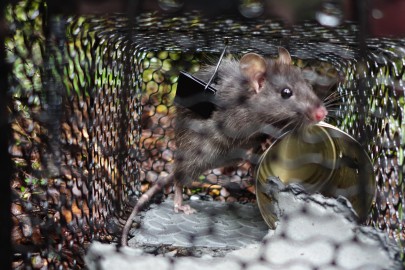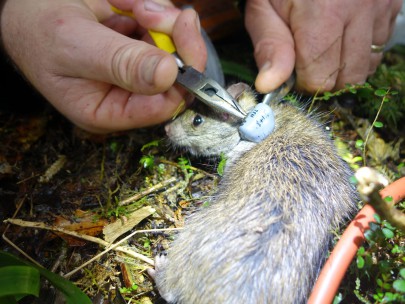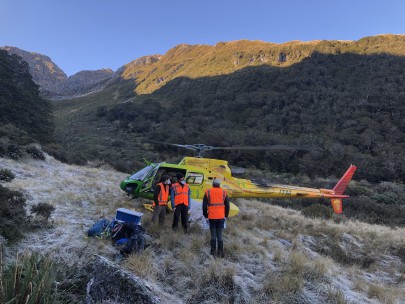
Rat in a live capture trap. Image: Max Harvey
Understanding how altitude and food availability regulate rat numbers should give conservationists the edge in protecting wildlife from rat plagues, which can lead to localised extinctions of native wildlife. To tease out these factors, the researchers have been intensively monitoring rat population dynamics at both high and low elevations in forested areas near the lake.
Since the study began 14 months ago, 912 individual rats have been live-captured and given a microchip and a metal tag in their ear before being released. Rats at high elevation are also being fed to see whether they can survive cold temperatures when they have sufficient food.
“Rats are generally less common in cold, high-altitude forests across New Zealand than in warm, lowland forests,” says study lead Dr Jo Carpenter, a postdoctoral researcher at Manaaki Whenua. “But it’s not clear whether that’s because rats can’t handle cold temperatures, or because there is typically less food there, especially in winter.”
“If it’s temperature that normally limits rats from living up high, and not food, we might expect to see high-elevation forests supporting more rats as the climate warms,” says Manaaki Whenua researcher Dr Adrian Monks. “This could have devastating consequences for some of our native birds, which currently use these colder environments as refugia from pests.”
The study also has direct implications for pest control. Cost-effective pest management relies on knowing where and when pest numbers are high so that management can be focused in the right place at the right time.
The preliminary results have been startling. Following the beech seed mast in 2019 the population density at Lake Alabaster reached a phenomenal 17 rats per hectare. These are some of the highest rat densities ever measured on the New Zealand mainland and reflect the incredible ability of rats to multiply rapidly following beech seeding.
Although food helped sustain the rats through the autumn, during the winter the rats being fed declined as much as the rats that were not fed. This suggests that another factor – perhaps temperature or predation by stoats – is limiting rats. Once this is known, it should be possible to create a ‘weather forecast’ about likely rat numbers for conservation managers, which will involve making predictions about rat numbers based on the climate and forest at a site. In turn, this will allow rat control to be done as effectively as possible, resulting in more birds in the bush.



